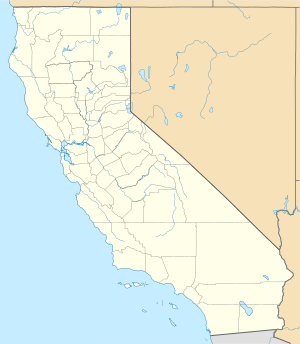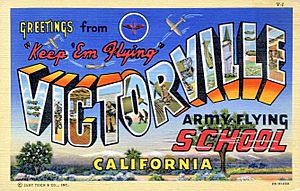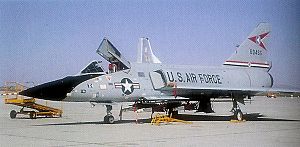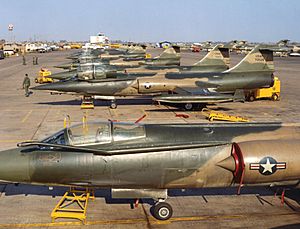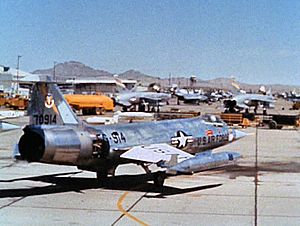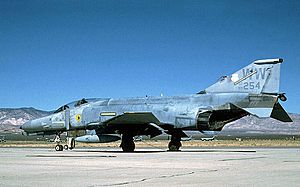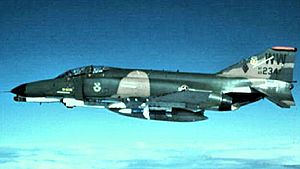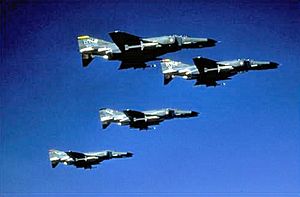George Air Force Base facts for kids
Quick facts for kids George Air Force Base |
|
|---|---|
| Victorville, California | |

2006 USGS airphoto
|
|
| Coordinates | 34°35′41″N 117°23′03″W / 34.59472°N 117.38417°W |
| Type | Air Force Base |
| Site information | |
| Controlled by | United States Army Air Forces United States Air Force |
| Condition | Civilian Airport, private ownership |
| Site history | |
| Built | 1941 |
| In use | 1941–1992 |
| Battles/wars | World War II Korean War Vietnam War 1991 Gulf War (Defense of Saudi Arabia; Liberation of Kuwait) |
George Air Force Base was a United States Air Force base in Victorville, California. It was about 8 miles northwest of the city center. This base was roughly 75 miles northeast of Los Angeles.
The base started as an Advanced Flying School in June 1941. It was first used by the United States Army Air Corps. After World War II, it closed down. But it reopened in November 1950 when the Korean War began. It became a training base again.
George AFB continued as a training base through the Cold War. It mainly trained pilots and weapon systems officers. These pilots were from the USAF, NATO, and other allied countries. They learned to fly front-line fighter jets. The base closed in 1993.
The decision to close George AFB came from the 1988 Base Realignment and Closure (BRAC) Commission. Today, the site is home to the Southern California Logistics Airport. Since 2009, the California Air National Guard has used part of the site. They train pilots for MQ-1 Predator remotely piloted aircraft.
| Top - 0-9 A B C D E F G H I J K L M N O P Q R S T U V W X Y Z |
History of George Air Force Base
How the Base Got Its Name
George Air Force Base was named after Brigadier General Harold Huston George. He was a brave fighter pilot in World War I. He served in the 185th and 139th Aero Squadrons.
At the start of World War II, he was in the Philippines. He led air operations to defend islands in Manila Bay. Sadly, he died in an aircraft accident in Australia in April 1942. The base was named in his honor in June 1950.
George AFB During World War II
In April 1940, leaders from Victorville, California suggested building an airfield. They chose the Mojave Desert because it had lots of sunny days. It also had wide-open spaces and nearby towns.
In 1941, the United States Army Air Corps agreed. They started building the 2,200-acre base on July 12, 1941. It was first called Victorville Army Air Field.
The base had four runways and seven hangars. It also had many support buildings. These included barracks, offices, and maintenance shops. The buildings were made quickly and cheaply for wartime use. The airfield could support over 4,000 military people.
Training began in February 1942. Pilots learned to fly planes like the Curtiss AT-9 and T-6 Texan. Bombardiers trained on AT-11s and BT-13 Valiants. The first class of pilots graduated in April 1942.
A special school for bombardiers also operated here. They practiced bombing runs at nearby Muroc Army Air Field. Glider pilots for Waco CG-4 gliders also trained at Victorville Field. Gliders were important for carrying troops and equipment. They were used in the D-Day invasion in 1944.
In 1944, new training began for P-39 Airacobra pilots. Training for B-24 Liberator bombardiers also started. A RADAR training school for bombardiers was added in September.
After Germany surrendered in May 1945, training slowed down. All training stopped on August 15. The base was put on standby status in October 1945.
After the War
After World War II, Victorville Army Airfield stored extra aircraft. Many planes like the Boeing B-29 Superfortress were parked in the desert. The base was renamed Victorville Air Force Base in January 1948. It became George Air Force Base in June 1950.
The Cold War Era
The Korean War started in June 1950. This meant the Air Force needed more training. George AFB was reactivated in November 1950. It had been unused for five years. Many old buildings needed repairs. The base was quickly updated for jet aircraft.
George AFB became a key training center during the Cold War. It focused on preparing pilots for fighter jets.
Recent History and Current Use
The old military housing at George AFB is now used for different things. It has been a filming location for movies like Jarhead. It was also used for an episode of Mythbusters.
The abandoned housing is also popular for airsoft games. These are like mock military battles. Several event organizers use the site for large airsoft events.
Main Air Force Units and Their Missions
George Air Force Base was home to many important Air Force units. These units trained pilots and maintained aircraft. They played a big role in defending the United States and supporting allies.
Early Fighter Units
When George AFB reopened in 1950, the 1st Fighter-Interceptor Wing was assigned there. They flew F-86A Sabre jets. These planes were used to defend the skies.
Other units also came to George AFB. The 327th Fighter-Interceptor Squadron was the first to fly the F-102A. The 329th Fighter-Interceptor Squadron was the first to fly the F-106A. These were advanced interceptor jets.
Training Fighter Pilots
The 479th Tactical Fighter Wing was at George AFB from 1952 to 1971. This wing trained pilots for various fighter jets. They started with F-86Fs and later used the North American F-100A Super Sabre. They were the first to use the F-100.
In 1958, they started flying the Lockheed F-104C Starfighter. The 479th TFW trained pilots from other countries on the F-104. They also sent squadrons overseas. Some F-104s were deployed to Thailand during the Vietnam War.
In 1965, the 479th TFW began training pilots for the McDonnell Douglas F-4C Phantom II. This was a very important fighter jet. They trained pilots from countries like Israel, Iran, Japan, and West Germany.
Wild Weasel Missions
The 35th Tactical Fighter Wing took over in 1971. Their main job was to train F-4 flight crews. In 1973, they started training aircrews for "Wild Weasel" missions. These missions involved finding and destroying enemy radar systems.
They used F-105F/G aircraft at first. By 1975, they received new F-4G aircraft. These F-4Gs had advanced Wild Weasel systems. George AFB became the only "Wild Weasel" training wing in the world.
In 1981, the 37th Tactical Fighter Wing took over the F-4G "Wild Weasel" training. They trained pilots for other "Wild Weasel" wings around the world. Their aircrews won worldwide gunnery meets in 1985 and 1987.
Operation Desert Storm
In August 1990, the 35th Tactical Fighter Wing helped in Operation Desert Shield. They sent 24 F-4Gs to Bahrain. These planes were crucial for suppressing enemy air defenses during Operation Desert Storm.
The F-4G aircrews flew many combat missions. They fired missiles at Iraqi targets. The wing did not suffer any casualties during these operations. The personnel and aircraft returned to George AFB in March 1991.
Environmental Cleanup and Closure
George Air Force Base was named a superfund site in 1990. This means the Environmental Protection Agency identified it for cleanup. Jet fuel and other substances had contaminated the water supply. Cleanup efforts are still ongoing to make the area safe.
George Air Force Base officially closed in December 1992. President Bill Clinton had a plan to help communities where bases closed. Part of this plan was to speed up environmental cleanup. This allowed the base property to be used again by the community.
Names and Commands of the Facility
Over the years, the base had several names:
- Air Corps Advanced Flying School (1941)
- Victorville Army Flying School (1942)
- Victorville Army Air Field (1943)
- Victorville Air Force Base (1948)
- George Air Force Base (1950)
It was assigned to different major commands, including:
- West Coast Air Corps Training Center (1941)
- Army Air Forces Training Command (1943)
- Air Materiel Command (1945)
- Continental Air Command (1950)
- Air Defense Command (1951)
- Strategic Air Command (1951)
- Tactical Air Command (1951-1992)
- Air Combat Command (1992)
Images for kids


